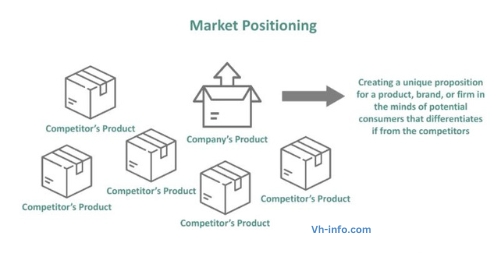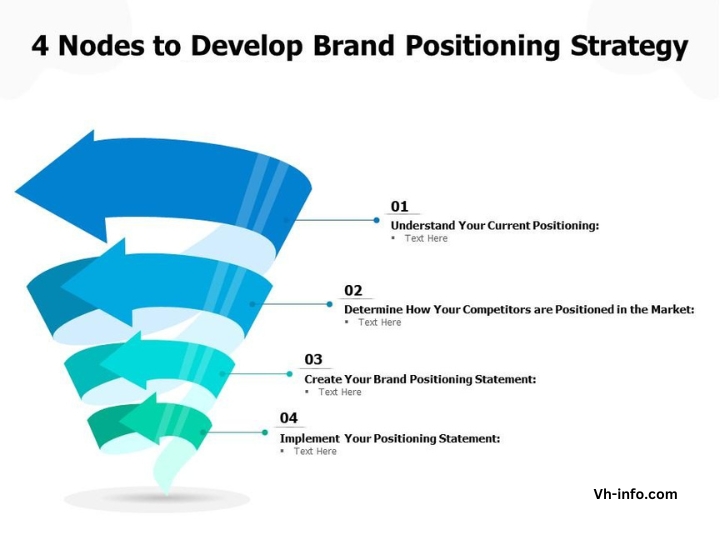Are you tired of your brand getting lost in the sea of competitors?
Do you want to stand out and make a name for yourself in the market? This is where Market Positioning comes into play.
It is not just about what your product does, but also how it differs from your competitor’s product and how it can cater to the needs of your target audience.
In this ultimate guide, we will dive deep into the importance of positioning in marketing, and its benefits, and give you five examples of successful market positioning strategies used by some of the biggest names in the industry.
We will also take you step-by-step through developing an effective positioning strategy that will set you apart from your competition.
By the end of this post, you’ll have a clear understanding of how to create a brand identity that resonates with your customers and grows your business.
What is Market Positioning?

Market positioning refers to how a company’s product or service is perceived by customers to competitors.
It is about making your product stand out from similar offerings and giving customers a reason to choose you over other options. Companies try to position their products as superior based on things like price, product quality positioning, features, or brand image.
The goal of positioning is to establish your product in the minds of customers and potential customers.
Effective positioning can help make a product seem unique and desirable compared to the competition, thus enhancing marketing efforts and addressing customer pain points and customer satisfaction.
By listening to customer needs and clearly defining how you want customers to view your product relative to alternatives, you can better target marketing messages and strengthen your place in the market and attract a loyal customer base, ultimately communicating your core values and brand’s competitive advantage effectively.
this should look like a PR pitch, just add it in quotations as an expert opinion; “By listening to customer needs and clearly defining how you want customers to view your product relative to alternatives, you can better target marketing messages and strengthen your place in the market and attract a loyal customer base, ultimately communicating your core values and brand’s competitive advantage effectively.” says Jacek Zmudzinski, Team Lead at Makolab.com
What does Positioning mean in Marketing?

Positioning refers to how a product or brand is perceived in the mind of the consumer in relation to competing products or brands. Effective positioning gives a product a clear, distinct, and desirable place in the market relative to substitutes.
The objective of market positioning is to establish the image or identity of a brand or product, known as the brand’s identity, so that consumers perceive it in a certain way, such as providing convenience at a reasonable price.
This allows marketers to better communicate the unique value and differentiating benefits of their offering, including increased customer loyalty, using a brand positioning map with different sets of attributes.
Successful companies like Coca-Cola and Band-Aid have one important thing in common: a strong brand positioning strategy. In fact, their brand names have become generic terms for all similar products in their niche.
The Importance Of Positioning In The Marketing
Positioning is crucial in marketing as it allows brands to stand out from the competition and give customers a reason to choose their product over alternatives.
There are several key reasons why positioning is important:
- Creates a distinct image in the minds of consumers. An effective positioning strategy establishes a unique, differentiated identity for a brand. This makes the product more memorable.
- Informs marketing strategy and messaging. Positioning provides focus for communications and indicates how the product should be marketed to appeal to target customers.
- Allows brands to charge premium pricing. A strong positioning enables brands to be perceived as superior. This means they can command higher prices.
- Guides product development decisions. Positioning indicates gaps in the market, showing product features or enhancements that would help reinforce the desired identity.
- Builds loyalty among target audience. By fulfilling the promise of the positioning, brands meet the needs and expectations of their core customers better than competitors. This builds preference and loyalty.
So, Positioning is a strategic cornerstone for marketing. It guides marketing decisions and enables brands to connect with consumers in a meaningful, differentiated way. Strong positioning provides focus and direction while weak positioning can lessen relevance and lose customer mindshare.
Benefits of Positioning in Marketing
There are good reasons to include positioning in your marketing plan. When you position things right, you can make better ads, improve your offering, improve your customer service, and set prices that keep you competitive.
Here are five benefits of using positioning in marketing:
Create a strong competitive position
Deciding how your product or service stands compared to others is important. If people see your product in a good way, you can keep doing well in the market. This helps you find your place among competitors and stay ahead.
Improve Sales
Every business aims to sell more and make more money. Using task management software can make this happen by helping businesses organize their work, decide which tasks are most important, and use resources better. If your business has something valuable and talks about it well, you might even reach new customers and sell more. You can also try affordable methods like sending emails to connect with possible new customers and improve sales team.
Define a Clearer Target Market
Using positioning in marketing means saying you’re really good at something specific and tailoring your products or services to match. This way, you look like an expert in that area, and people will see your worth more.
Make more Effective Decisions
When you have a clear main message for successful positioning, it helps you make better choices along the way. Clear positioning in marketing also helps you talk better with customers and build better relationships with them.
Connect to Consumer Needs
When companies use positioning in marketing, they can tell people about the important good things their product or service does. This doesn’t just make the product look good but also links it to the exact customer who needs it.
Examples of Positioning in Marketing
Tesla

Tesla doesn’t talk much about how much their cars cost; instead, they emphasize how good their vehicles are.
That’s why Tesla is seen as a fancy brand, and its cars are pricier than others.
Tesla cars can go a long way, are good for the environment, and run on electricity. They stand out from other luxury cars and regular electric cars because of their high quality.
Tesla has found its own special group of customers and made a fun brand to go along with it. The CEO, Elon Musk, even acts like a cool character, similar to Tony Stark.
The company shows off its uniqueness in ads and with cool features like “Ludicrous Mode.”
Starbucks

Starbucks thought carefully about who they wanted to sell coffee to, especially because fewer people were drinking coffee in the U.S. since the 1960s. They chose people who work in offices and earn a good amount of money.
Starbucks wanted to be a special place, not home or work, where people could meet, chill, and chat. They were strict about making sure everything they offered was really good.
In their ads, they often talk about these things as their value proposition:
- Having the best coffee
- Using the best milk
- Having rich and smooth flavors
- Using natural and clean stuff
- Using 100% recycled paper
All of these things in their ads tell potential customers that they’ll get really good, clean, and fancy drinks.
With such a smart marketing plan for their social media and superior product positioning combined with proper market research, it’s no wonder Starbucks has been the top coffee choice and a market leader in America for a long time. People have an emotional connection & just love it!
Dollar Shave Club

Dollar Shave Club shows through its name that it’s all about being affordable.
The company wants to be known for being easy to use and not expensive, making it a brand that regular people can connect with.
Unlike their big competitor, Gillette, who uses a very manly style in their messages and looks, Dollar Shave Club is more laid-back and playful.
Gillette has a smooth appearance and uses guys who seem like models, but Dollar Shave Club shows regular people of different ages who are easier for customers to relate to.
Nike

When Nike began, they were all about making things that help people perform better and creating new ideas. They even made a shoe called the waffle shoe.
At first, they aimed their brand at people who are really into sports. Now, they sell more than just shoes; they have clothes too, all made for better performance.
With their famous saying “Just Do It” and being named after the Greek Goddess of Victory, Nike has made itself the top choice for sports gear. They are known for giving high-quality stuff with cool, new technology.
Apple

Apple is a perfect example of a smart marketing plan. They make things that are well-designed and new, unlike anything else.
Their message is all about connecting with people who are creative and think in innovative ways, just like their products.
Similar to Tesla, Apple doesn’t talk much about how much their iPhones cost.
Instead, they focus on the good things you get with their products and building a strong relationship with their customers.
How to Create an Effective Market Positioning Strategy?

Creating an effective market positioning strategy involves several steps that help make your business stand out.
First, understand how people see your products now and figure out if they view them as unique or just like everything else in the market. Identify your ideal customers and how you can connect with them.
Next, analyze your competitors to know your strengths and weaknesses compared to them. Create a positioning map, a visual tool to see where you stand in the market. Adjust your current position by emphasizing your strengths and showing potential customers why your business is the go-to for certain values.
Craft a brief positioning statement that summarizes your mission, target audience, and the main benefit your product offers.
For example, Amazon’s statement is, “Our vision is to be the Earth’s most customer-centric company, to build a place where people can come to find and discover anything they might want to buy online.”
Develop a tagline or slogan that reflects your brand and what customers can expect. Test your positioning strategy over time, track progress, and be ready to make adjustments.
Remember, it’s a process, and the effectiveness may not happen immediately, so stay committed to the effort.
How to Develop a Positioning Strategy?

Step 1. Analyze relevance to your audience
Research your target audience, including their demographics, values, needs and problems. This allows you to identify the benefits your brand can offer that are most relevant and appealing to your customers. Focus on meaningful differentiation.
Step 2. Define your Brand
Clearly determine what your brand represents and your core brand identity. Reflect on your brand values, personality, strengths and unique capabilities. Your positioning should stem from your brand definition.
Step 3. Develop your Positioning Statement
Craft a concise statement summarizing what makes your brand distinct and worthwhile to customers. Include your target market, frame of reference to competitors, key benefit and brand personality. This guides marketing decisions.
Step 4. Identify competitors and analyze their strategies
Examine direct and indirect competitors. Evaluate their positioning strategies and perceived strengths/weaknesses from a customer perspective. Use this to further refine your differentiation.
Step 5. Implement a strategy and maintain a reputation
Integrate your positioning across marketing channels through messaging, visuals and experiences. Deliver on your positioning consistently over time through products and services. Monitor feedback to ensure your reputation aligns.
Effectively Position Your Brand with Smart Marketing Tactics
When developing your marketing positioning, it’s important to understand the different types of positioning available, such as focused differentiation and value positioning.
An effective positioning strategy starts with in-depth qualitative research and market segmentation to identify your target audiences and their needs. From there, you can develop positioning that speaks to the TOFU and BOFU audiences you want to reach.
Integrate your positioning across the 5 Ps of marketing – product, price, promotion, place and people. For financial services, focus on building trust and expertise.
Measure success with paid acquisition and hone your focused differentiation strategy. With smart marketing tactics, you can effectively position your brand in the minds of your target audience.
Conclusion
In conclusion, market positioning is a crucial aspect of marketing that can greatly impact the success of your business. It helps define your brand, connect with your target audience, and differentiate yourself from competitors.
By creating a strong competitive position, improving sales, defining a clearer target market, making more effective decisions, and connecting to consumer needs, you can establish a successful market position.
Analyzing relevance to your audience, defining your brand, developing your positioning statement, identifying competitors and analyzing their strategies, and implementing a strategy and maintaining a reputation are key steps in developing an effective market positioning strategy.
Remember, your positioning strategy should align with your overall business goals and objectives.

